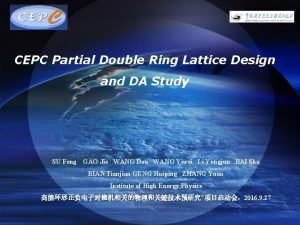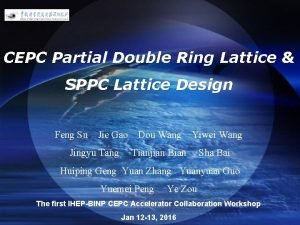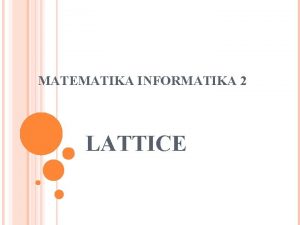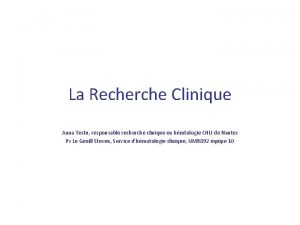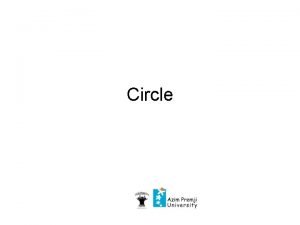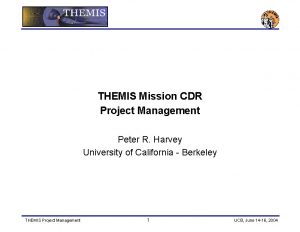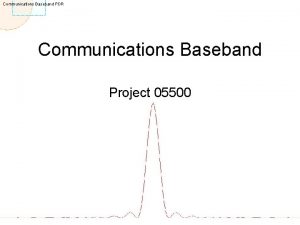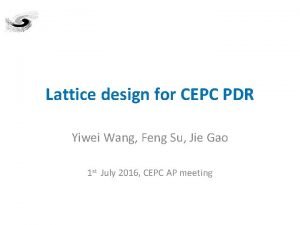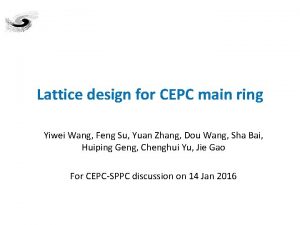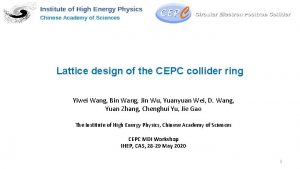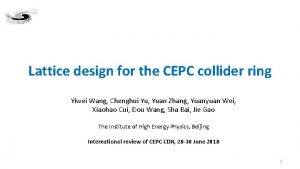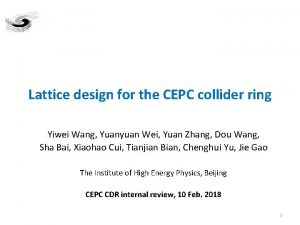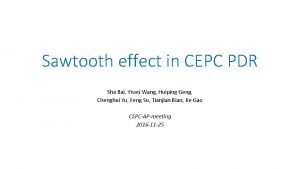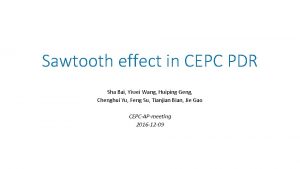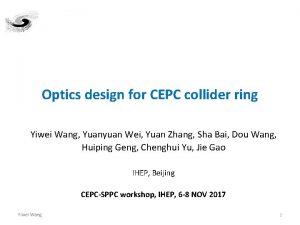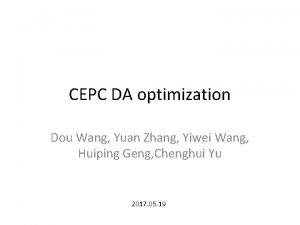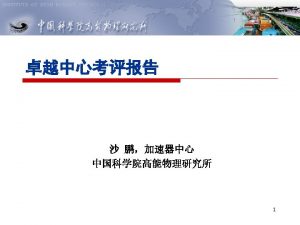ARC lattice design for CEPC PDR Yiwei Wang











- Slides: 11

ARC lattice design for CEPC PDR Yiwei Wang, Feng Su, Jie Gao 20 th May 2016, CEPC AP meeting

CEPC primary parameter (wangdou 20160325) Number of IPs Energy (Ge. V) Circumference (km) SR loss/turn (Ge. V) Half crossing angle (mrad) Piwinski angle Ne/bunch (1011) Bunch number Beam current (m. A) SR power /beam (MW) Bending radius (km) Momentum compaction (10 -5) IP x/y (m) Emittance x/y (nm) Transverse IP (um) x/IP y/IP VRF (GV) f RF (MHz) Nature z (mm) Total z (mm) HOM power/cavity (kw) Energy spread (%) Energy acceptance by RF (%) n Life time due to beamstrahlung_cal (minute) F (hour glass) Lmax/IP (1034 cm-2 s-1) Pre-CDR H-high lumi. H-low power W Z 2 120 54 3. 1 0 0 3. 79 50 16. 6 51. 7 6. 1 3. 4 0. 8/0. 0012 6. 12/0. 018 69. 97/0. 15 0. 118 0. 083 6. 87 650 2. 14 2. 65 3. 6 0. 13 2 6 0. 23 47 2 120 54 2. 96 15 2. 85 67 16. 9 50 6. 2 2. 5 0. 25/0. 00136 2. 45/0. 0074 24. 8/0. 1 0. 03 0. 11 3. 62 650 3. 1 4. 1 2. 2 0. 13 2 2. 2 0. 47 36 2 120 54 2. 96 15 2. 67 44 10. 5 31. 2 6. 2 2. 2 0. 268 /0. 00124 2. 06 /0. 0062 23. 5/0. 088 0. 032 0. 11 3. 53 650 3. 0 4. 0 1. 3 0. 13 2 2. 1 0. 47 32 2 80 54 0. 59 15 5 0. 74 400 26. 2 15. 6 6. 1 2. 4 0. 1/0. 001 1. 02/0. 003 10. 1/0. 056 0. 008 0. 074 0. 81 650 3. 25 3. 35 0. 99 0. 09 2 45. 5 54 0. 062 15 7. 6 0. 46 1100 45. 4 2. 8 6. 1 3. 5 0. 1/0. 001 0. 62/0. 0028 7. 9/0. 053 0. 006 0. 073 0. 12 650 3. 9 4. 0 0. 99 0. 05 1. 7 0. 3 1. 1 0. 24 0. 68 2. 04 0. 82 2. 96 0. 81 2. 01 0. 92 3. 09 0. 95 3. 09

Considerations on ARC lattice design • FODO cell, 90 /90 – non-interleaved sextupole scheme – n=5 – All 3 rd and 4 th RDT due to sextupoles cancelled – Amplitude-dependent tune shift is very small Ncell= 120 LB= 19. 96 Lcell= 47. 92 theta=. 0032188449319567555 Lring= 54820. 47999996 Nstr 1= 18 Nstr 2= 20 Vrfc= 220625000 frf= 6. 5 e+08

this lattice NIP=2 Eng=120 Lring=54820. 48 U 0=2. 933 theta. C=theta. P=Ne=2. 67 Nb=44 Ib=. 0105 Pbeam=30. 800 rho. B=6200 alfap=1. 668 E-5 bxstar=bystar=ex=2. 094 e-09 ey=0 sigx. IP=sigy. IP=ksix=ksiy=Vrf=3. 53 e+09 frf=6. 5 e+08 sigmaz=. 00264 sigmazt=Phom=sigmae=. 00130 eapt=eaptrf=ngamma=tbs=Fhg=Lmax=- H-low power wangdou 20160325 NIP=2 ! Number of IPs [1] Eng=120 ! Energy [Ge. V] Lring=54*1 E 3 ! Circumference [m] U 0=2. 96 ! SR loss/turn [Ge. V] theta. C=15 ! Half crossing angle [mrad] theta. P=2. 6 ! Piwinski angle [1] Ne=2. 67 ! Ne/bunch [10^11] Nb=44 ! bunch number [1] Ib=10. 5*1 e-3 ! Beam current[A] Pbeam=31. 2 ! SR power/beam [MW] rho. B=6. 2*1 e 3 ! Bending radius [m] alfap=2. 2 e-5 ! Momentum compaction [1] bxstar=0. 268 ! beta x at IP [m] bystar=0. 00124 ! beta y at IP [m] ex=2. 06*1 e-9 ! emittance x [m*rad] ey=0. 0062*1 e-9 ! emittance y [m*rad] sigx. IP=23. 5*1 e-6 ! beam size x at IP [m] sigy. IP=0. 088*1 e-6 ! beam size y at IP [m] ksix=0. 032 ! ksix/IP [1] ksiy=0. 11 ! ksiy/IP [1] Vrf=3. 53*1 e 9 ! Vrf [V] frf=650*1 e 6 ! frf [Hz] sigmaz=3. 0 ! Nature sigmaz [mm] sigmazt=4. 0 ! Total sigmaz [mm] Phom=1. 3 ! HOM power/cavity [kw] sigmae=0. 13/100 ! Energy spread [1] eapt=2/100 ! energy acceptance [1] eaptrf=2. 1/100 ! energy acceptance by RF [1] ngamma=0. 47 ! number of gamma tbs=32 ! life time due to beamstrahlung [min] Fhg=0. 81 ! Factor of hour glass Lmax=2. 01 ! Lmax/IP [10^34/cm^2/s] Damping time 15 ms, i. e. 82 turns; filling factor 72. 2%

FODO cell ARC lattice Dispersion Suppressor Whole ARC (w/o FFS, PDR)

2 families of sextupoles SF 1 =(L =. 3999999997 K 2 =. 9680546863280827 ) SD 1 =(L =. 3999999997 K 2 =-1. 8843252788821787 ) No strong resonance line in dp/p=2%

Optimization of DA with non-interleaved sextupoles • Optimize bandwidth of Q vs. dp/p and constraint the break down of –I – In SAD, Q(dp/p) is calculated w/o synchrotron motion. However, the results will be very different between w/ and w/o synchrotron motion. • Optimize the DA vs. dp/p directly – Four cases should be optimized together: (0, 0), (0, Pi/2), (Pi/2, 0), (Pi/2, Pi/2) – w/o damping

8 families of sextupoles SF 1 SD 1 SF 13 SD 13 SF 25 SD 25 SF 37 SD 37 =(L =. 3999999997 K 2 =1. 0049552085951383 ) =(L =. 3999999997 K 2 =-1. 8774102185487131 ) =(L =. 3999999997 K 2 =. 9570321356746315 ) =(L =. 3999999997 K 2 =-1. 8569945561714651 ) =(L =. 3999999997 K 2 =. 9829370588944072 ) =(L =. 3999999997 K 2 =-1. 848948069693812 ) =(L =. 3999999997 K 2 =1. 012913577646016 ) =(L =. 3999999997 K 2 =-1. 8893114648552132 )

32 families of sextupoles Priliminary result for 32 families Further optimization is possible: initial setting, different configuration of families

DA vs. Circumfence If fix emittance, L Dx K 2 DA (FODO cell, 90 /90 )

Summary • An ARC lattice designed for the CEPC PDR – FODO cell, 90 /90 , non-interleaved sextupole scheme – Most of the lattice parameters are consistent with the design goal • The dynamic aperture is optimized directly. – 2 families: (55 55) for dp/p=0, (15 10) for dp/p=2% – 8 families: (55 55) for dp/p=0, (27 18) for dp/p=2% – Further optimization is possible: initial setting, more families • A larger ring has a bigger DA.
